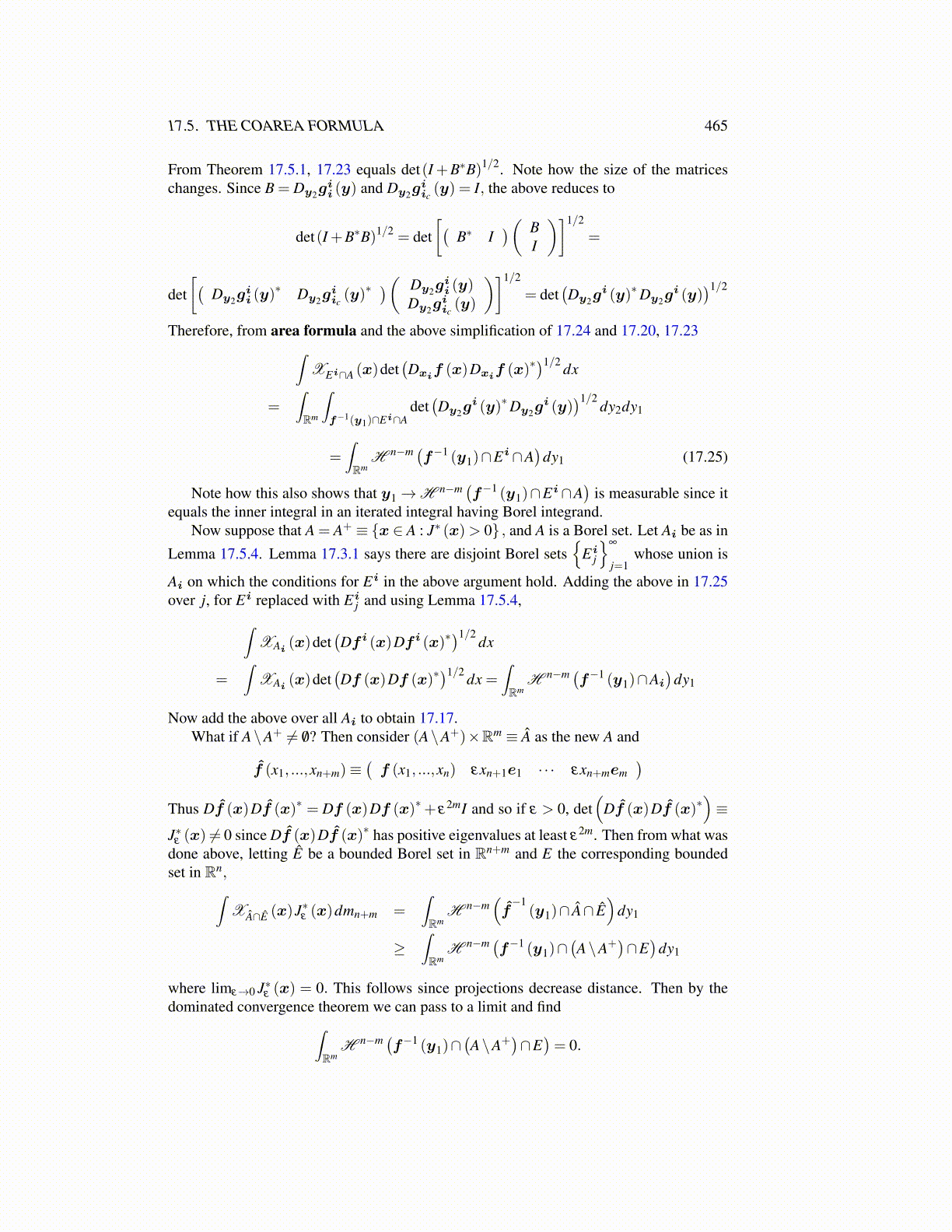
17.5. THE COAREA FORMULA 465
From Theorem 17.5.1, 17.23 equals det(I +B∗B)1/2. Note how the size of the matriceschanges. Since B = Dy2g
ii (y) and Dy2g
iic(y) = I, the above reduces to
det(I +B∗B)1/2 = det[(
B∗ I)( B
I
)]1/2
=
det[(
Dy2gii (y)
∗ Dy2giic(y)∗
)( Dy2gii (y)
Dy2giic(y)
)]1/2
= det(Dy2g
i (y)∗Dy2gi (y)
)1/2
Therefore, from area formula and the above simplification of 17.24 and 17.20, 17.23∫XEi∩A (x)det
(Dxi
f (x)Dxif (x)∗
)1/2 dx
=∫Rm
∫f−1(y1)∩Ei∩A
det(Dy2g
i (y)∗Dy2gi (y)
)1/2dy2dy1
=∫Rm
H n−m (f−1 (y1)∩Ei∩A)
dy1 (17.25)
Note how this also shows that y1→H n−m(f−1 (y1)∩Ei∩A
)is measurable since it
equals the inner integral in an iterated integral having Borel integrand.Now suppose that A = A+ ≡ {x ∈ A : J∗ (x)> 0} , and A is a Borel set. Let Ai be as in
Lemma 17.5.4. Lemma 17.3.1 says there are disjoint Borel sets{
Eij
}∞
j=1whose union is
Ai on which the conditions for Ei in the above argument hold. Adding the above in 17.25over j, for Ei replaced with Ei
j and using Lemma 17.5.4,∫XAi
(x)det(Df i (x)Df i (x)∗
)1/2dx
=∫
XAi(x)det
(Df (x)Df (x)∗
)1/2 dx =∫Rm
H n−m (f−1 (y1)∩Ai
)dy1
Now add the above over all Ai to obtain 17.17.What if A\A+ ̸= /0? Then consider (A\A+)×Rm ≡ Â as the new A and
f̂ (x1, ...,xn+m)≡(f (x1, ...,xn) εxn+1e1 · · · εxn+mem
)Thus Df̂ (x)Df̂ (x)∗ = Df (x)Df (x)∗+ ε2mI and so if ε > 0, det
(Df̂ (x)Df̂ (x)∗
)≡
J∗ε (x) ̸= 0 since Df̂ (x)Df̂ (x)∗ has positive eigenvalues at least ε2m. Then from what wasdone above, letting Ê be a bounded Borel set in Rn+m and E the corresponding boundedset in Rn,∫
XÂ∩Ê (x)J∗ε (x)dmn+m =∫Rm
H n−m(f̂−1
(y1)∩ Â∩ Ê)
dy1
≥∫Rm
H n−m (f−1 (y1)∩(A\A+
)∩E)
dy1
where limε→0 J∗ε (x) = 0. This follows since projections decrease distance. Then by thedominated convergence theorem we can pass to a limit and find∫
RmH n−m (f−1 (y1)∩
(A\A+
)∩E)= 0.